Although it is widely known that Dirk Obbink had an association with the Green Collection (and later the Museum of the Bible) going back at least as far as 2010, the recent news that Professor Obbink was also (legally) selling manuscripts to the Greens as early as 2010 casts a somewhat different light on the development of both the Green Collection and the Museum of the Bible enterprise.
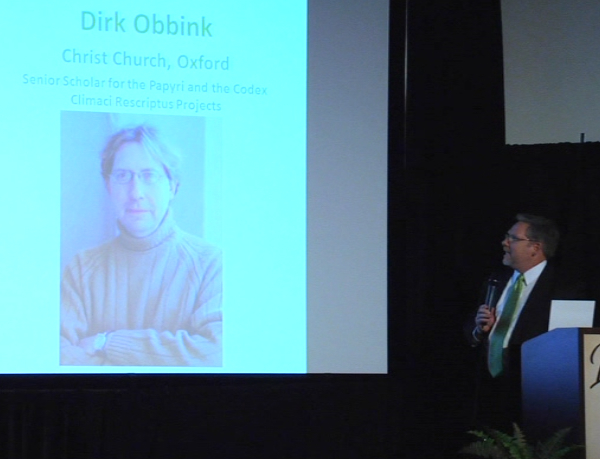
As is well known, Professor Obbink was one of the first “senior scholars” in the Green Scholars Initiative. It is unclear exactly when and how this relationship began. When Jerry Pattengale introduced a “Passages Speakers Series” talk by Professor Obbink on 13 September 2011, he fondly recalled a history of visits to Oxford:
“There are regular trips that take place, and, um, Steve and Jackie Green, and I think some of the other Greens have actually met with Dr. Obbink there, and some, some very serious discussions have taken place about the scholarship that is transpiring there at Oxford.”
While Pattengale and the Greens did make visits to see Obbink over the years, that history of “regular trips” to Oxford in the early days seems to have mostly involved Scott Carroll. These excursions could for a time be documented by Scott Carroll’s facebook posts. But it appears that these are no longer publicly available. Nevertheless, in his many online lectures, Carroll frequently brought up his stays at Oxford, often mentioning Professor Obbink by name.
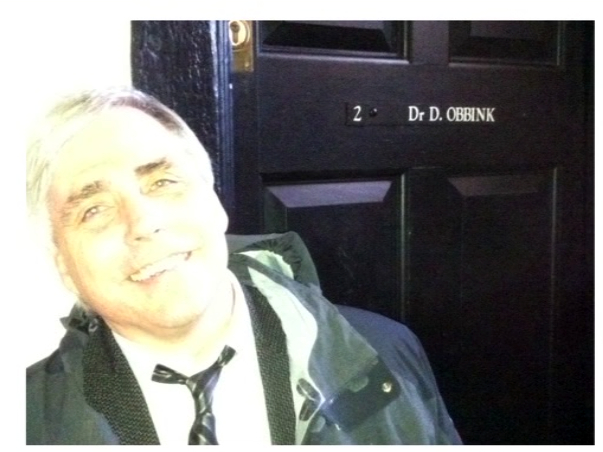
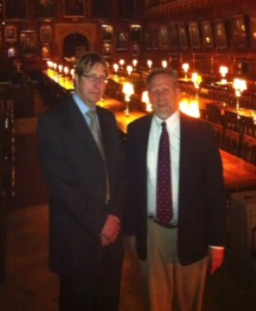
But even after the parting of ways between the Greens and Scott Carroll in May of 2012, relations between Dirk Obbink and the Green Collection continued and in some ways deepened. When the effort to publish the results of the Green Scholars Initiative led to a contract with Brill in August of 2012 for a series then known as The Green Scholars Initiative: Papyrus Series, the two editors of the series were Pattengale and Professor Obbink. In the spring of 2013, Pattengale and Professor Obbink again teamed up for a VIP event associated with the Green Collection “Passages” exhibit in Colorado Springs, in which Pattengale and Professor Obbink dissolved mummy cartonnage for an audience:
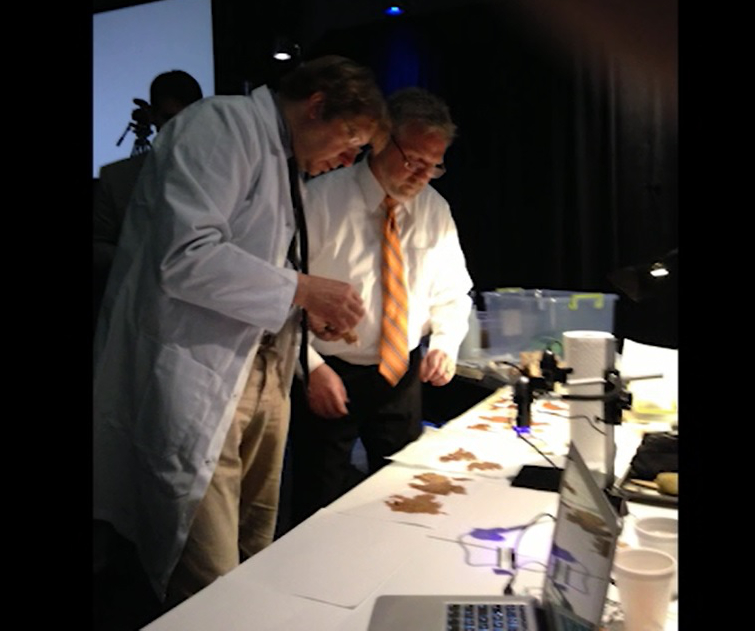
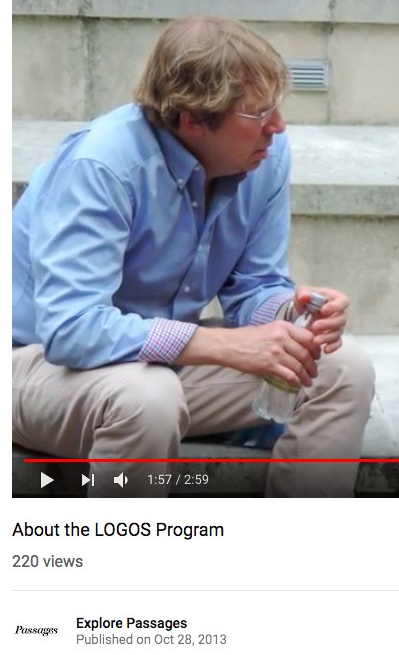
In fact, such performances were planned to be a permanent part of the Museum of the Bible facilities in Washington, DC. There were plans to build “a laboratory display . . . designed to show how early text fragments are recovered from mummy cartonnage” and in which “visitors will be able to participate in the actual procedure, and others can watch from outside the glass box in the museum.” Professor Obbink was also involved in the annual Green-sponsored “LOGOS in Oxford” conferences designed by Jerry Pattengale. He appeared in promotional material for the program in 2013 and was listed as an instructor as recently as 2016. Even in May of 2015, when Professor Obbink explicitly told Candida Moss and Joel Baden that he was “not involved in the study of [the Green] Collection,” representatives of the Museum of the Bible at the highest levels were still in close touch with Professor Obbink. In fact, members of the organization were in Oxford at that very time. Cary Summers, former chief operating officer and president of the Museum of the Bible, tweeted the following in May of 2015:
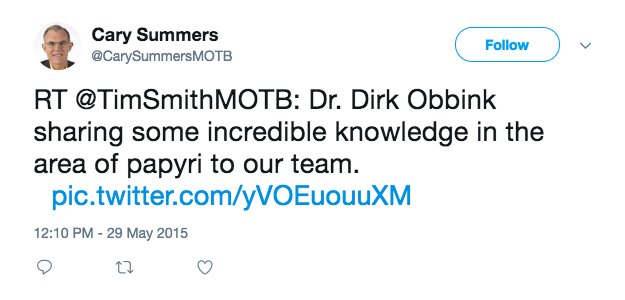
Regrettably, the link to the photograph in the tweet is dead, so it is unclear which members of the “team” were meeting with Professor Obbink, but the fact that surrounding tweets indicate that Summers himself was in Oxford at that time suggest he was probably included in the meeting.
In general, Professor Obbink seems to have maintained links throughout this period with the Museum of the Bible and figures in the orbit of the organization. For instance in the image below, Professor Obbink shares some unpublished papyri with Jeremiah Johnston and Craig A. Evans in 2017:
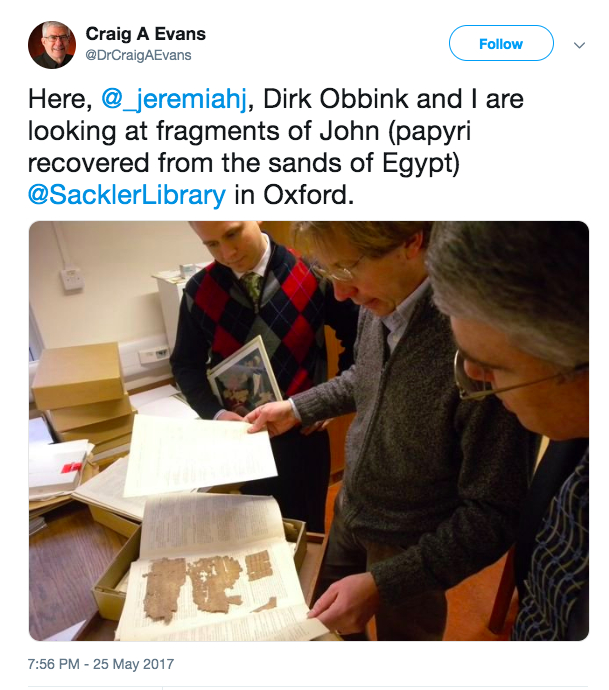
Michael D. Press has shown through tax documents that a financial relationship between the Museum and Professor Obbink continued through 2017. Although the documents cited by Press do not specifically name Professor Obbink, they refer to projects for which Obbink is the principal investigator. The money, however, seems to have gone directly to Professor Obbink personally, since at least one of the projects named seem not to have been sponsored by the Museum of the Bible.
And finally, thanks to Candida Moss, we now know that Professor Obbink’s antiquities business in Oxford, “Oxford Ancient,” even shared an office with the “Museum of the Bible Fellowship”:

The point of all of this is to say that Professor Obbink was involved in a surprisingly broad range of activities associated with the Green Collection and the Museum of the Bible over the life of the organization: sale of artifacts, research with Scholars Initiative, academic publication, and publicity.
Furthermore, if the documents provided by Mike Holmes attesting to the sale of the Oxyrhynchus gospels are what they appear to be, the fact that Professor Obbink, in his role as a seller of manuscripts, seems to have insisted that “Buyer and Seller shall safeguard and keep confidential all information regarding the subject matter of the scholarly research” raises the question of whether it was Professor Obbink himself who was the instigator for the culture of secrecy in the Museum of the Bible that has been a source of so many of the Museum’s troubles.
And finally, we must keep in mind that we have yet to learn the full extent of the sales that Professor Obbink made to the Greens. Recall that even on the invoice for the four Oxyrhynchus gospels, two of the items (which, unlike the gospels in dispute, were presumably actually delivered to the Greens) were blacked out. How many more sales did Professor Obbink make to the Greens? Only he or the Green Collection / Museum of the Bible can provide those answers.
[[Update 3 July 2019: A couple other points should be added.
- I did not mention Professor Obbink’s appointment as “Visiting Distinguished Professor of Classics” (I believe in 2015) at Baylor University, which was established early on as “the academic home” of the Green Scholars Initiative (Scott Carroll and Jerry Pattengale also held appointments there as “Research Professor” and “Distinguished Senior Fellow,” respectively).
- A comment by A.K. below points out that Professor Obbink was one of several academics that took part in the study of Museum of the Bible papyri in Oklahoma City in August 2016.
- A comment by Jon on the Evangelical Textual Criticism blog points out that Professor Obbink sold the Greens some bookbinding tools in 2011, and the Museum of the Bible provenance records for the items contain a note stating that “Museum of the Bible ascertained in a private meeting with Dr. Dirk Obbink in December 2017 that this object was previously with The Romantic Agony Auctions in Brussels prior to Obbink’s acquisition.” This suggests that the Museum of the Bible was conducting ongoing meetings and work with Professor Obbink to determine (well after the initial sale of the items) issues of ownership history.]]


Fascinating Brent
Nevertheless your account maybe misses a dimension; in that there appear always to have been three in this marriage ; not just Obbink and the Greens, but also the Egypt Exploration Society. Various persons have cast doubt on the reliability of Jerry Pattengale’s article; nevertheless there is the interesting passage:
“Before the EES became aware of this particular case, that the “First-Century Mark” was actually its own, Obbink reported to Steve Green (chair of the Museum of the Bible’s board) and me that the EES gave him an ultimatum to sever all public ties with our museum or be fired. His name had started surfacing in connection with other rare pieces and our museum, like the Sappho manuscripts he published, and the contract with Brill Publishers for a series. I invited him to the contract signing in Leiden and he appeared in their press release photo with our museum representatives. The sheer volume of all these new texts was raising concern. We happened to be in Oxford on the day of Obbink’s fateful meeting with the EES in London, and upon his return we sat long into the night on the patio of Oxford’s Cotswold Lodge Hotel listening to this distraught esteemed scholar. He was facing a reality that neither the EES nor we fully understood, nor could we until later—he evidently was playing both ends against the middle.
I confided in Peter Williams, warden of Tyndale House, Cambridge, and even discussed arranging a meeting with the eminent Kenneth Kitchen and his EES colleagues to understand more fully the situation. I put forth an internal proposal to fund a professorship in Kitchen’s name at Christ Church, should the progenitor agree, assuming that Dirk would not accept the EES’s conditions. But he did, and I was outvoted anyway in favor of a plan in Waco, Texas. The meeting with Kitchen never took place, and Obbink’s dual role at Baylor began. Keep in mind: Obbink was the heralded scholar in his field, a papyrology rock star if you will. And rather enjoyable. This was an amazing catch for Baylor.”
So, sometime before spring 2016, the EES had taken issue with some of the ties between Dirk Obbink and the Greens/Museum of the Bible; and insisted at a showdown meeting in London, that he “accept the EES’s conditions”. It would seem that Pattengale was aware of those conditions in detail. But what were those ‘conditions’, did Obbink abide by them; and, crucially, might the the Museum of the Bible have been knowingly complicit in any subsequent actions of Obbink that may have breached them? The EES have announced recently that “Professor Obbink has not been a General Editor of the Oxyrhynchus Papyri since August 2016”; but have given no context for this. Was this one of the 2016 ‘conditions’; or was it effected due to a subsequent breach of the ‘conditions’, or were the EES already suspecting that Obbink had been offering EES fragments for sale? And if so, why did the EES statement of May 2018 implicitly endorse Obbink’s denials?
I do not think the culture of secrecy and cover-up on this matter is confined to Professor Obbink, and the Greens.
The 2018 EES statement did not “implicitly endorse Obbink’s denials”, come on. It’s Britain! The statement says over and over “Professor Obbink says…”, “Professor Obbink insists…”, while everything else is described in factual terms. Whatever did in fact happen between Obbink and the Greens, the EES statement made it very clear that they were merely reporting Obbink’s words without an ounce of endorsement. I had a distinct impression from the beginning that they may not in fact have believed him, and recent events seem to confirm this impression (now they have actual evidence to work with, as opposed to mere lack of trust in him).
the EES statement in 2018 stated ; “Papyrus 5345 was excavated by Grenfell and Hunt, probably in 1903, and has never been for sale, whatever claims may have been made arising from individual conversations in the past.”
The second part of that statement we now know to have been false. Would the EES have expressed it so baldly, if they had reason then to suspect that Obbink was being less than honest?
The later expansion did make it clear that this absolute statement depended on Professor Obbink’s assurances; but even so, nowhere is that dependency spelled out as conditional. However this later clarification was very much an afterthought; the EES had originally expected their absolute denial to stand unqualified.
If you want to see how the EES might have phrased their statement, had they not been willing to believe Obbink;s assurances; then you need only compare with the statement made a week ago.
Tom, supply “legally” after “for sale” and you’ll certainly have a true statement. I suspect the EES meant it in that sense—indeed, can you even sell, in the legal sense, property over which you have no legal title? (And I assume a lawyer wrote that statement, especially given British libel law.)
But the statement that the papyrus “has never been for sale” is factually true and doesn’t depend on the question of Obbink’s reliability (though note the important qualification that immediately follows). If I try to sell your house which I don’t own, it doesn’t mean that your house is for sale!
See also https://enipolatio.hypotheses.org/the-art-of-reading-documentary-papyri , dated 8/23/2016: “This week Drs. Lincoln Blumell, Jeffrey Fish, Kevin Funderburk, and Dirk Obbink (head of the Oxyrhynchus Papyri Project) came to OKC to study some of the papyri in the MOTB Museum Collections.” etc.
Thanks. I had heard about events like these, but I hadn’t seen any public record of them.
Re “and current president of the Museum of the Bible,” he is no longer president.
Thanks for the update. I fixed the text. Do you have a link to a new story for that? Is he still part of the organization?
https://www.museumofthebible.org/press/press-releases/museum-of-the-bible-appoints-ken-mckenzie-chief-executive-officer-in-run-up-to-institutions-first-anniversary
said CS will be “museum relations officer.”
Thanks for your superb (ongoing) reporting on this, Brent.
Thanks for the link. Now that I see the press release, I do vaguely recall hearing about this “shake up” in the organization.
I don’t get why people wear labcoats if they can’t be bothered buttoning them up.
The reasons why Carroll and the Greens parted ways has been unclear. I cannot help but to speculate about Obbink’s possible influence. With Obbink’s alleged use of NDA’s and Carroll’s penchant to drop “bread crumbs” about papyri, I wonder if Obbink grew uncomfortable with Carroll’s public comments, especially concerning FCM, and if an ultimatum was given – either Carroll goes or Obbink goes. Interestingly, Carroll left the Green Collection shortly after the Wallace-Ehrman debate with no explanation. Perhaps the Greens perceived that Obbink had more upside than Carroll, including his ability to supply papryri. This might also explain Carroll’s comments on ETC after the publication of P137.
Thank you, Brent, for this very informative series of posts. So valuable!
“culture of secrecy in the Museum of the Bible that has been a source of so many of the Museum’s troubles” Maybe if they hadn’t been importing thousands of illegal antiquities they could have eliminated some trouble. You deleted my last comment when I brought this up, but that MOTB organization broke the law when it suited them. I guess it’s the cynic in me, but I don’t see that leopard changing its spots. I think there is more to be revealed in their relationship with Obbink and I don’t mean good things.
Thanks, Greg. I wasn’t aware I deleted your one of your comments. I don’t see any in the pending queue. Do you recall which post the comment was on?
Do we know who went on an ancient manuscript/artifacts shopping spree? Was it Carroll or Pattengale or both? I thought it was Carroll, but I’m not sure.
From what I have seen online and in Moss and Baden’s Bible Nation, it seems like Scott Carroll was the main middleman connecting the Greens with sellers.
Brent: with reference to your first supplementary point;
Alan Jacobs, of Baylor University, has noted that the links into Dirk Obbink’s name have been removed from the Baylor web pages of both the Department of Classics and the Institute for Study of Religion https://blog.ayjay.org/a-scholarly-mystery/
Obbink said he wanted to spend more time with his Manuscript Family.
Seriously, if you haven’t seen it check out Hennell’s editing of Dirk Obbink Wikipedia:
https://en.wikipedia.org/wiki/Dirk_Obbink
Pingback: Livius Nieuwsbrief | Juli 2019 – Mainzer Beobachter
You write: “These excursions could for a time be documented by Scott Carroll’s facebook posts. But it appears that these are no longer publicly available.”
If needed, drop me an email and I can share some screenshots from those previously public Facebook posts, which I made in June/July 2017. I don’t know why exactly those posts disappeared (made private/deleted?) sometime before mid-2018, but it seems to have been done very selectively.
Thanks, Rick. I’ll follow up on that.
Pingback: Dirk Obbink, Scott Carroll, and Sappho | Variant Readings
Pingback: Dirk Obbink, Scott Carroll, and a Papyrus of Plato | Variant Readings
Pingback: Recently Emerged Papyri of Dubious Origins: A Working List | Variant Readings
Pingback: A Statement from Dirk Obbink | Variant Readings
Pingback: Hobby Lobby and Penance: Some Observations and Suggestions | Variant Readings
Pingback: Some Additional Thoughts on Sabar’s Atlantic Article | Variant Readings